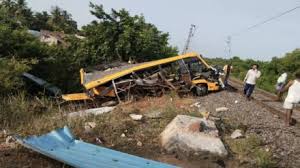3 students killed as train hits school van in Tamil Nadu’s Cuddalore

In a heartbreaking incident on the morning of July 8, 2025, three school students were killed and several others injured when a passenger train collided with a private school van at a level crossing in Tamil Nadu’s Cuddalore district. The collision occurred at Semmankuppam near the Capper Hills area, casting a shadow of grief over the local community.
According to eyewitnesses and preliminary reports, the van carrying around eight schoolchildren was attempting to cross the tracks at Gate No. 170—a manned level crossing—when the Villupuram–Mayiladuthurai passenger train struck it. The crash was so intense that the van was tossed aside and mangled beyond recognition.
Who Were the Victims?
Among the deceased were:
- V. Nimilesh, 12 years old
- D. Charumathi, 16 years old
- Chezhiyan, 15 years old
These young lives, filled with dreams and promise, were cut short in a matter of seconds. All of them were students at a private school in the region, reportedly en route to class when tragedy struck.
What Went Wrong?
Initial investigations have pointed to possible negligence at multiple levels. Reports suggest that the school van was driven onto the railway crossing even as the gatekeeper was in the process of closing the gate to let the train pass. Shockingly, it is alleged that the van driver requested the gatekeeper to reopen the gate, and the latter complied. Moments later, the van was hit at full speed by the oncoming train.
The gatekeeper has since been suspended, pending a full inquiry. An official from Southern Railway confirmed that a committee consisting of officers from various departments—including safety, operations, and engineering—has been formed to look into the incident.
This tragedy has reignited concerns about the safety protocols at manned railway crossings, particularly in semi-urban and rural areas where vigilance may be lax and infrastructure outdated.
Eyewitness Accounts
Several residents near the railway crossing described the scene as horrifying.
“I was hanging laundry when I heard a massive crash,” said a local woman. “The van was crumpled like a paper ball. Children were screaming and some were thrown several feet away.”
Another resident added that the train came to a halt only after dragging the van a considerable distance. Emergency services and railway staff responded quickly, and injured students were rushed to Cuddalore Government Hospital.
Condition of the Injured
At least five others, including students and a 55-year-old bystander, were injured in the incident. The bystander reportedly suffered burns from overhead electric cables that snapped during the collision. Two of the students are said to be in critical condition and may be transferred to JIPMER in Puducherry for advanced medical care.
Doctors at the government hospital described the injuries as severe but treatable, though they remain cautious about the condition of the most critically hurt students.
Immediate Government Response
Tamil Nadu Chief Minister M.K. Stalin expressed deep sorrow over the loss of young lives and extended his condolences to the grieving families. He also announced a compensation of:
- ₹5 lakh each to the families of the deceased students
- ₹1 lakh for the injured individuals
Southern Railway has also stepped in with additional compensation: ₹5 lakh for the deceased, ₹2.5 lakh for the seriously injured, and ₹50,000 for those with minor injuries.
A relief train was dispatched from the Southern Railway zone, and railway doctors were sent to Cuddalore to assist local medical teams.
Calls for Accountability and Reform
This tragedy has sparked outrage among parents, school officials, and safety advocates. The fact that such an accident occurred at a manned level crossing has raised serious questions.
“How could the gatekeeper open the gate when a train was approaching? And why did the driver not wait for it to pass?” asked one angry parent outside the hospital. “This is criminal negligence.”
Transportation experts have long warned about the dangers posed by manned railway crossings in India, particularly those lacking interlocking systems. These systems prevent barriers from being raised manually once a train is detected, but many crossings still rely on human judgment.
A Pattern of Preventable Accidents
Sadly, this is not the first time such a tragedy has occurred. India has witnessed several deadly accidents involving school buses or vans being hit by trains at level crossings. In many cases, they are due to poor coordination, lack of automatic signaling, or disregard for safety protocols.
While the Railways have made progress in eliminating unmanned crossings over the past decade, manned crossings still account for a significant share of accidents, especially when infrastructure and monitoring are inadequate.
Community in Mourning
Schools in and around Semmankuppam remained closed for the day as a mark of respect. Candlelight vigils were held by local residents, with people of all ages coming together to mourn the children. Black flags were also seen outside schools and homes, symbolizing collective grief.
“It’s not just the parents who have lost their children,” said a teacher from the school the children attended. “We have all lost a part of our future.”
What Happens Next?
An official investigation is underway to determine exact liability, assess whether standard operating procedures were violated, and recommend policy changes. Both the van driver and gatekeeper may face legal action if found negligent.
The incident is likely to renew demands for automated barriers, CCTV surveillance, and stricter penalties for rule violations at crossings involving school transport vehicles.
Final Thoughts
The Cuddalore train accident is a painful reminder that when it comes to children’s safety, there is no room for shortcuts or complacency. The loss of three bright young lives is a tragedy that could—and should—have been avoided.
As the investigation continues, the hope is that concrete changes will emerge from this darkness, ensuring that no more families have to endure such avoidable pain.






